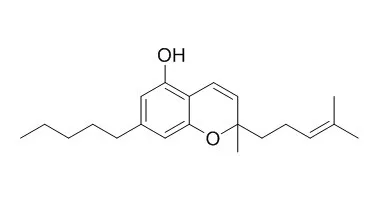| Description: |
Cannabichromene is a major non-psychotropic phytocannabinoid that inhibits endocannabinoid inactivation and activates the transient receptor potential ankyrin-1 (TRPA1), it selectively reduces inflammation-induced hypermotility in vivo in a manner that is not dependent on cannabinoid receptors or TRPA1; it can raise the viability of neural stem progenitor cells (NSPCs), while inhibiting their differentiation into astroglia, possibly through up-regulation of ATP and adenosine signalling. Cannabichromene exerts anti-inflammatory actions in activated macrophages with tonic CB1 cannabinoid signalling being negatively coupled to this effect and ameliorates experimental murine colitis. |
| Targets: |
NOS | COX | ERK | ATPase |
| In vitro: |
| Neurochem Int. 2013 Nov;63(5):432-7. | | The effect of cannabichromene on adult neural stem/progenitor cells.[Pubmed: 23941747 ] | Apart from the psychotropic compound Δ(9)-tetrahydrocannabinol (THC), evidence suggests that other non-psychotropic phytocannabinoids are also of potential clinical use. This study aimed at elucidating the effect of major non-THC phytocannabinoids on the fate of adult neural stem progenitor cells (NSPCs), which are an essential component of brain function in health as well as in pathology.
METHODS AND RESULTS:
We tested three compounds: cannabidiol, cannabigerol, and Cannabichromene (CBC), and found that CBC has a positive effect on the viability of mouse NSPCs during differentiation in vitro. The expression of NSPC and astrocyte markers nestin and Glial fibrillary acidic protein (GFAP), respectively, was up- and down-regulated, respectively. CBC stimulated ERK1/2 phosphorylation; however, this effect had a slower onset in comparison to typical MAPK stimulation. A MEK inhibitor, U0126, antagonized the up-regulation of nestin but not the down-regulation of GFAP. Based on a previous report, we studied the potential involvement of the adenosine A1 receptor in the effect of CBC on these cells and found that the selective adenosine A1 receptor antagonist, DPCPX, counteracted both ERK1/2 phosphorylation and up-regulation of nestin by CBC, indicating that also adenosine is involved in these effects of CBC, but possibly not in CBC inhibitory effect on GFAP expression. Next, we measured ATP levels as an equilibrium marker of adenosine and found higher ATP levels during differentiation of NSPCs in the presence of CBC.
CONCLUSIONS:
Taken together, our results suggest that CBC raises the viability of NSPCs while inhibiting their differentiation into astroglia, possibly through up-regulation of ATP and adenosine signalling. |
|
| In vivo: |
| Br J Pharmacol. 2013 May;169(1):213-29. | | The cannabinoid TRPA1 agonist cannabichromene inhibits nitric oxide production in macrophages and ameliorates murine colitis.[Pubmed: 23373571] | The non-psychotropic cannabinoid Cannabichromene is known to activate the transient receptor potential ankyrin-type1 (TRPA1) and to inhibit endocannabinoid inactivation, both of which are involved in inflammatory processes.
METHODS AND RESULTS:
We examined here the effects of this phytocannabinoid on peritoneal macrophages and its efficacy in an experimental model of colitis. LPS caused a significant production of nitrites, associated to up-regulation of anandamide, iNOS, COX-2, CB1 receptors and down-regulation of CB2 receptors mRNA expression. Cannabichromene significantly reduced LPS-stimulated nitrite levels, and its effect was mimicked by cannabinoid receptor and TRPA1 agonists (carvacrol and cinnamaldehyde) and enhanced by CB1 receptor antagonists. LPS-induced anandamide, iNOS, COX-2 and cannabinoid receptor changes were not significantly modified by Cannabichromene, which, however, increased oleoylethanolamide levels. In vivo, Cannabichromene ameliorated DNBS-induced colonic inflammation, as revealed by histology, immunohistochemistry and myeloperoxidase activity.
CONCLUSIONS:
Cannabichromene exerts anti-inflammatory actions in activated macrophages - with tonic CB1 cannabinoid signalling being negatively coupled to this effect - and ameliorates experimental murine colitis. | | J Anal Toxicol. 2011 Sep;35(7):496-500. | | Cannabichromene and tetrahydrocannabinol determination in mouse blood and brain by gas chromatography-mass spectrometry.[Pubmed: 21871159] | Cannabichromene (CBC) is a phytocannabinoid, the second most abundant cannabinoid quantitatively in marijuana. CBC has been shown to produce antinociception and anti-inflammatory effects in rodents.
METHODS AND RESULTS:
This method is validated for the measurement of THC and CBC simultaneously after extraction from mouse blood or brain. Whole brain harvested from mice was homogenized 2:1 (v/w) with normal saline. Fifty nanograms of THC-d₃ was added to 0.5 mL of heparinized mouse blood, brain homogenate, and THC and CBC fortified blood or brain calibrators, then equilibrated overnight at 5 °C. Two milliliters of "ice cold" acetonitrile was added drop-wise while the sample was vortex mixed, and then the sample was centrifuged and stored overnight at -30 °C. The cannabinoids were extracted from the acetonitrile layer with 2 mL of 0.2 N NaOH and 4 mL of hexane/ethyl acetate (9:1). The solvent was isolated and evaporated to dryness. Trimethylsilyl derivatives were prepared and then analyzed by gas chromatography-mass spectrometry. Linearity in blood and brain of THC and CBC was 2-10,000 ng/mL (ng/g). THC and CBC recovery ranged from 56 to 78% in blood and brain. Precision was demonstrated at 100 ng/mL and 1000 ng/mL with CVs < 15%.
CONCLUSIONS:
The validated method allows for blood and brain concentrations of cannabinoids to be quantificated and correlated with pharmacological effects produced in mice. |
|






 Cell. 2018 Jan 11;172(1-2):249-261.e12. doi: 10.1016/j.cell.2017.12.019.IF=36.216(2019)
Cell. 2018 Jan 11;172(1-2):249-261.e12. doi: 10.1016/j.cell.2017.12.019.IF=36.216(2019) Cell Metab. 2020 Mar 3;31(3):534-548.e5. doi: 10.1016/j.cmet.2020.01.002.IF=22.415(2019)
Cell Metab. 2020 Mar 3;31(3):534-548.e5. doi: 10.1016/j.cmet.2020.01.002.IF=22.415(2019) Mol Cell. 2017 Nov 16;68(4):673-685.e6. doi: 10.1016/j.molcel.2017.10.022.IF=14.548(2019)
Mol Cell. 2017 Nov 16;68(4):673-685.e6. doi: 10.1016/j.molcel.2017.10.022.IF=14.548(2019)